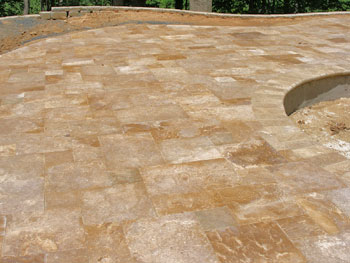Travertine Filler
Which Type Should You Use?
Many people wonder what is the best travertine filler for the joints in
travertine pavers. The main options are sand or polymeric sand. I do not
recommend concrete.
Sand and Stone Dust Fillers
This is the most common paving joint filler for paving materials that are dry laid, such as travertine pavers, concrete pavers, bluestone, etc.
Travertine pavers are laid on a layer of sand. After the pavers are laid on top of the sand, more sand is swept into the joints.
Most pavers have narrow joints, although tumbled travertine pavers have wavier edges. Therefore, the joints will be wider in areas and more obvious.
Can weeds be a problem? Occasionally, but typically this is not a big issue and I would not worry about it.
Polymeric Sand
Polymeric sand is a type of sand that can be used also. As with the sand above, it should be swept into the joints as the travertine filler.

The difference with this material is that you must then wet it down with a hose which causes it to harden.
The advantage of this method is that any weed problem is pretty much eliminated.
It is also a solid joint material.
The disadvantage is that if it is not done properly or installed in bad weather, slight cracks can appear in the joints.
I do not like polymeric sand, due to an experience I had. I have a brick patio laid in sand. Last winter there were repeated freeze/thaw conditions. The ground would freeze and then thaw out as the weather warmed.
My patio heaved over the winter. Came the spring, it settled back down and all was ok. I can just imagine what would have happened to the joints if they were polymeric sand! Therefore, I prefer sand in most installations.
I also experienced it cracking on an installation.
If you are wondering about the correct method to install travertine pavers (or tile), here are three pages to take a look at.
Paver Installation - general paver installation
Installing Travertine - my very simple instructions
Building a Patio - Diagrams showing installation methods to be used for travertine pavers and travertine tile
This
is good for a you to know whether you are doing the installation
yourself or hiring a landscaping company. The more knowledge is better!
Concrete Joints
There is no advantage for using concrete in the joints for pavers. To use concrete in the joints, the pavers must be set in concrete to begin with. One of
the great things about travertine pavers is that they can be dry laid
and thus easily removed if need be and replaced. Concrete joints can
crack, which is a big problem. Removals are difficult and repairs are
usually easily detected.
If you are using travertine tile, this material would be set in concrete and the joints would be the same.
Please also visit the following pages:
Travertine Paving Pictures - here are some travertine paving photos
Travertine Sealer - types of sealers explained
Types of Travertine - differences between honed, filled and tumbled travertine
Travertine Filler and Polymeric Sand- an installer's point of view (good)
Travertine Costs - see what one of my favorite projects cost
If you enjoyed this page, please share it!






